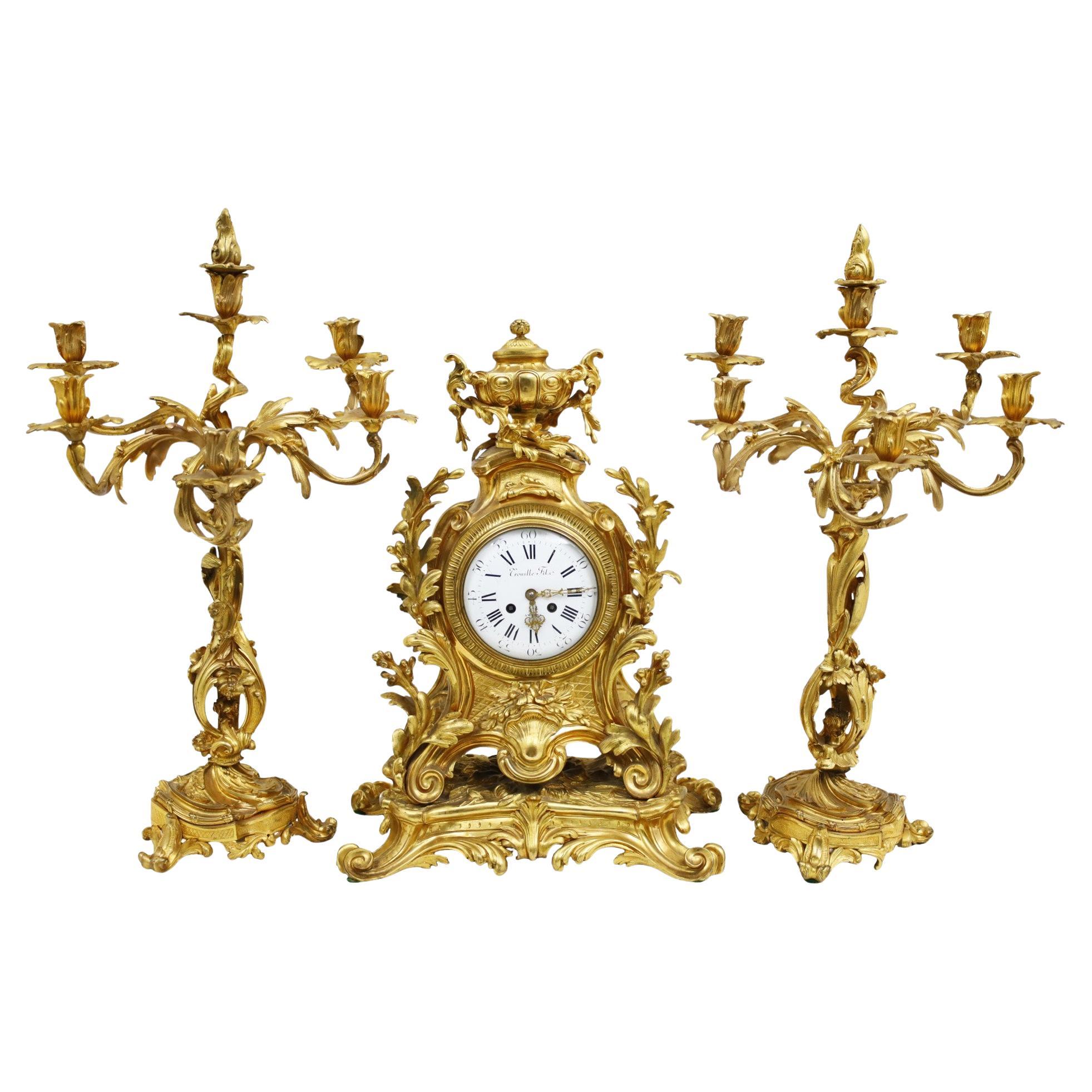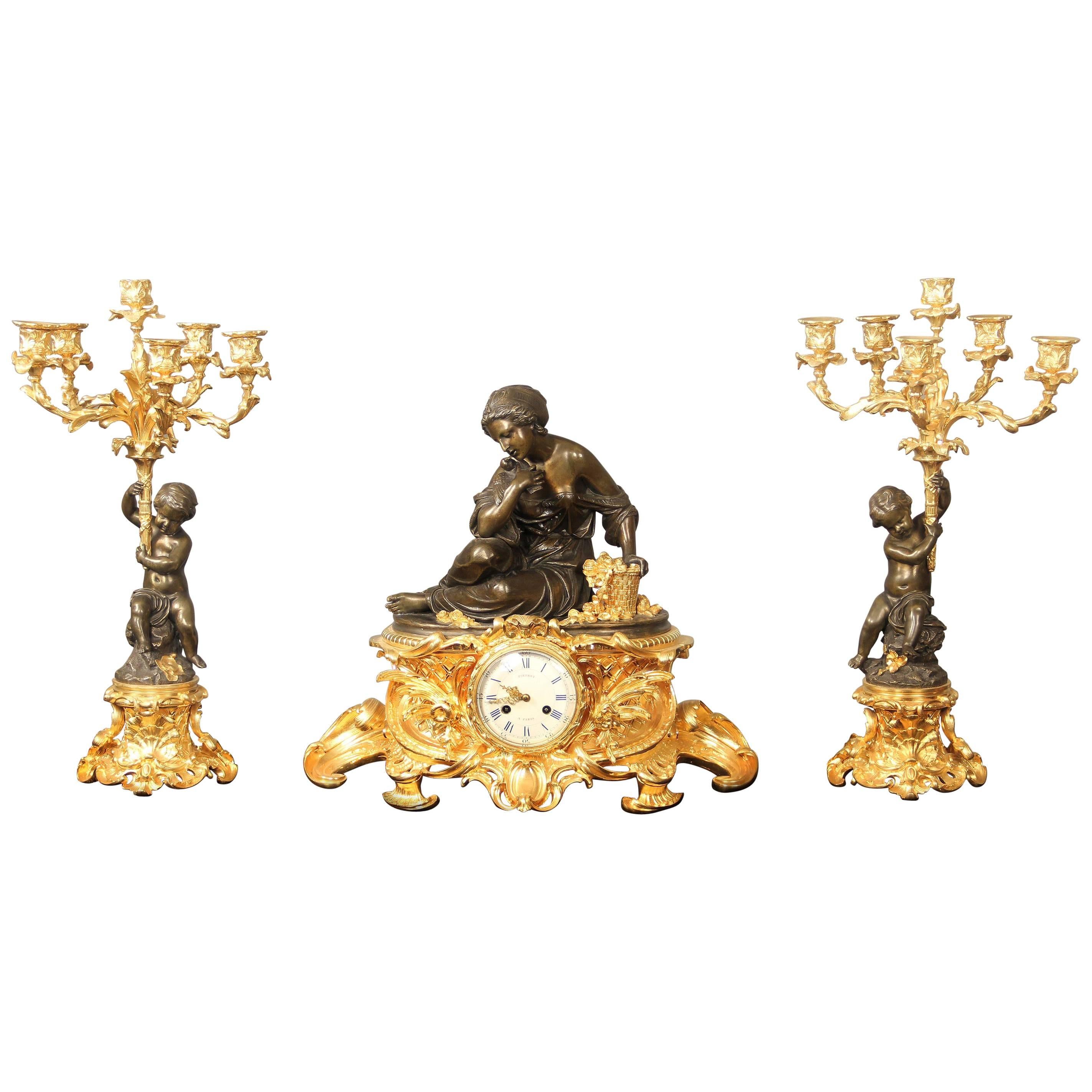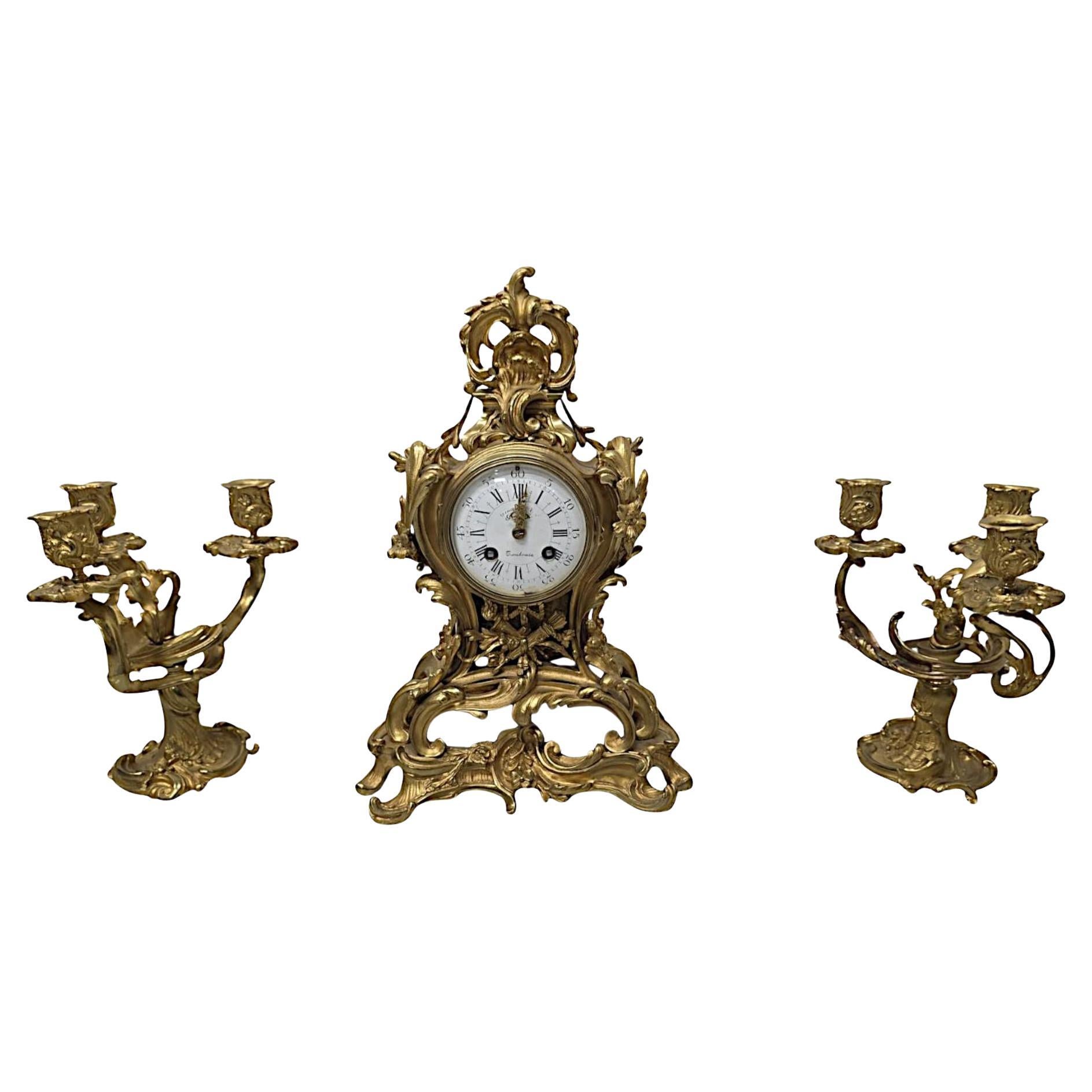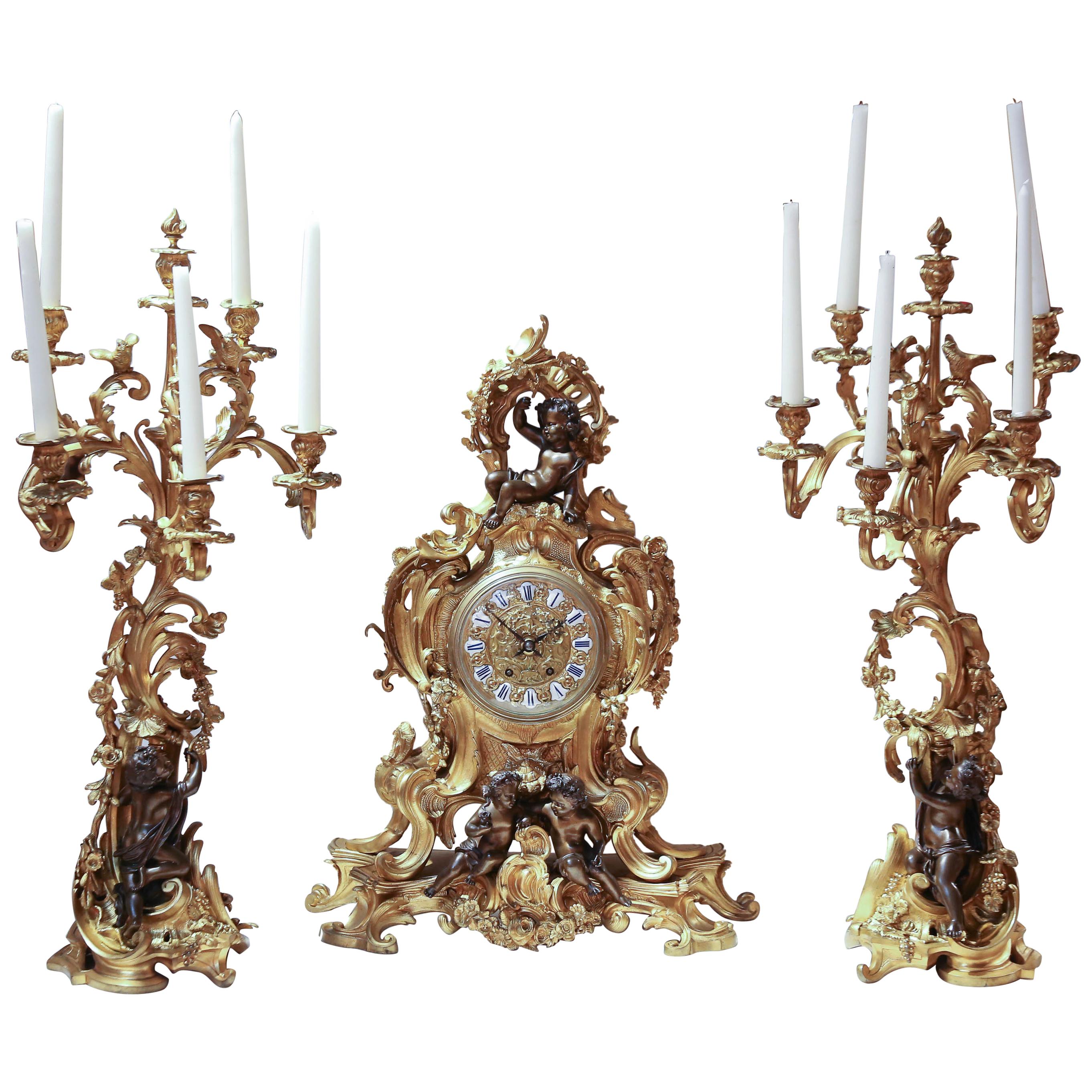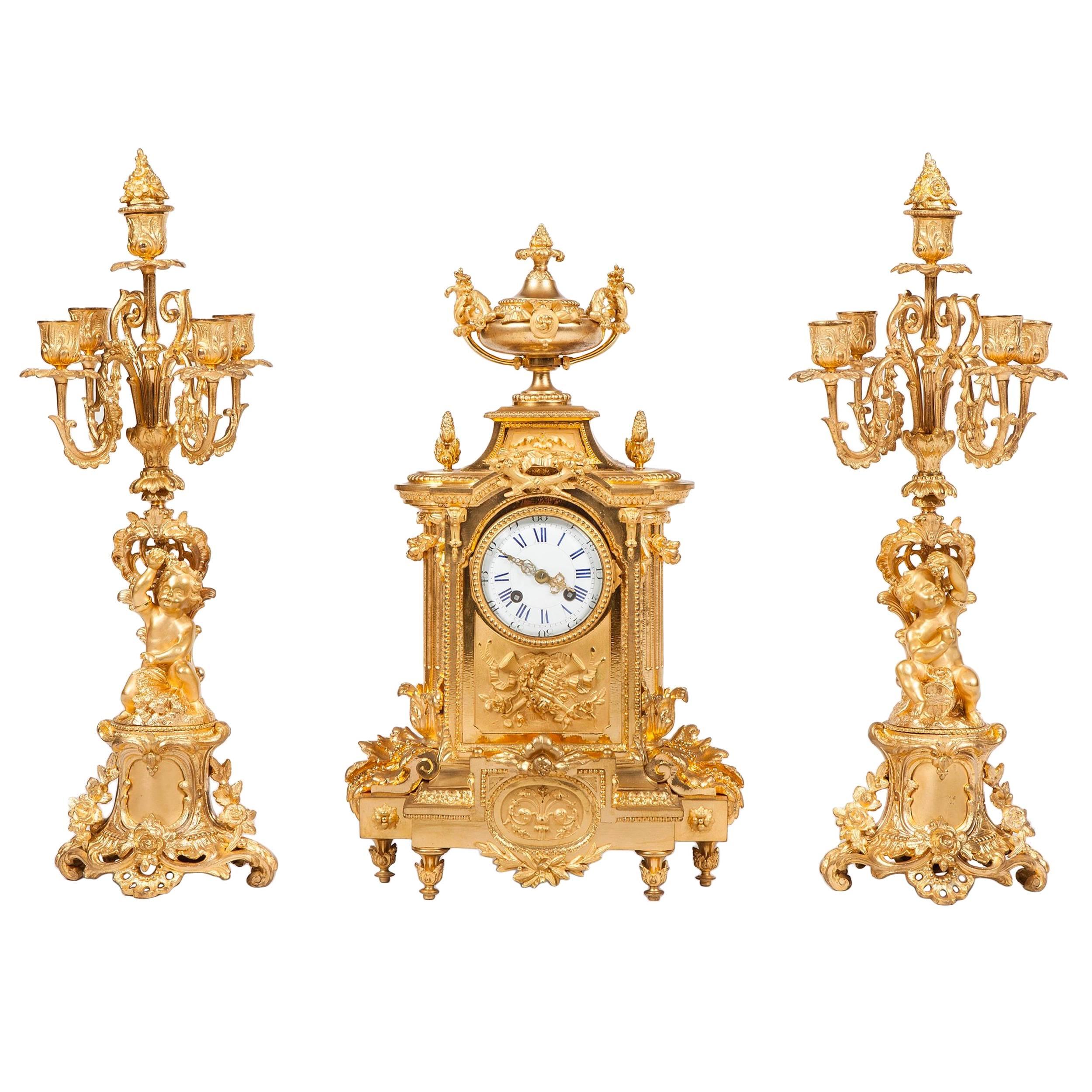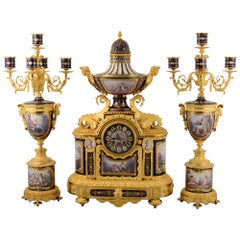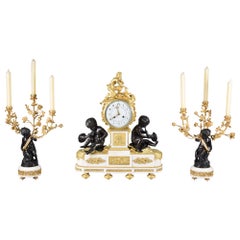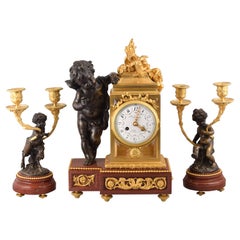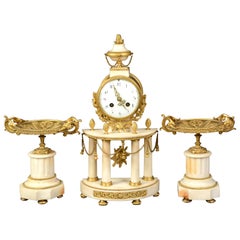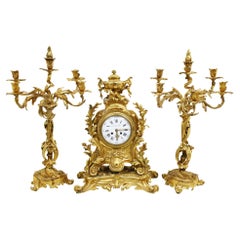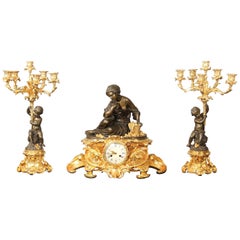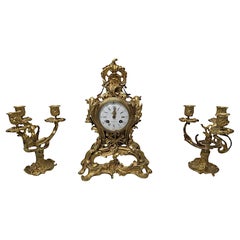Items Similar to Garnish, clock and two candlesticks. Gilt bronze. H Picard and V Paillard. 19thc
Want more images or videos?
Request additional images or videos from the seller
1 of 16
Garnish, clock and two candlesticks. Gilt bronze. H Picard and V Paillard. 19thc
$31,357.78per set
£23,653.43per set
€26,500per set
CA$44,000.46per set
A$47,981.70per set
CHF 25,206.04per set
MX$575,089.51per set
NOK 319,637.39per set
SEK 297,452.70per set
DKK 201,884.38per set
About the Item
Garnish, clock and two candlesticks. Gilt bronze. Henri Picard and Victor Paillard. Paris, France, 1831-1864.
With markings (base, back).
A gilded bronze clock with two four-light candelabras accompanied by flowers, with smooth bases and vase-shaped feet with a strong classical inspiration, decorated with reliefs (fauns, children's figures, garlands, grotesque heads, etc.). The clock has two female figures (allegories of Geography and Astronomy due to the objects they carry) flanking a vase containing the dial, which has Roman numerals for the hours and Arabic numerals every five for the minutes, as well as a signature. The Paris-type machinery has an engraved number and a seal (Vr Paillard / A Paris).
On the base area, on the back of the clock, the legend H. Picard is engraved, which refers to the founder and gilder Henri Picard (France, active 1831-1864), who worked for Defreveille, also collaborating with Charles Perrault and Grault. He produced numerous works for Napoleon III, many of which are preserved in the Louvre Museum in Paris. The inscription on the dial reads “Victor Paillard / Ft de Bronzes / A Paris”. Victor Paillard (1805-1886) was a French sculptor who completed his training in Paris with Jean-François Denière, also collaborating with Ferdinand Barbedienne. In 1830 he created a successful firm of movable art objects that received state commissions (especially for the Palau d'Afers Exteriors at the Quiai d'Orsay).
There is evidence of the existence of other clocks like the present one: one by the bronzesmith Étienne Martincourt with the dial signed “Lepaute à Paris”; another identical to this one and now in the Paul Getty Museum in Malibu (California, USA) from the Tuileries; and another with the dial signed by Victor Paillard. As for the model of the vases, it seems that they were inspired by some very popular and appreciated ones by Claude Michel (Clodion firm), who made an original in terracotta in 1763, on which numerous pieces in bronze and other materials were based (a pair in marble is preserved by the Art Institute of Chicago, dated 1766; one is in the Goncourt Collection dated 1761 or 1762; a pair of candelabras with these bases are known and attributed to Barbedienne, etc.). In turn, it seems that Clodion was inspired by some vases by François Boucher.
Weight: 57 kg. · Size: Reloj 60x27x72 cms Candelabros 32x25x83cm
International Buyers – Please Note: for those articles that need Export Permits (those older than 100 years), the obtaining of the Permit will be processed without additional expenses (if you choose the seller sends it to you), but the period for the obtention of it may vary from 10 to 35 days.
- Dimensions:Height: 32.68 in (83 cm)Width: 23.63 in (60 cm)Depth: 10.63 in (27 cm)
- Sold As:Set of 3
- Style:Other (In the Style Of)
- Materials and Techniques:
- Place of Origin:
- Period:
- Date of Manufacture:19th century
- Condition:Wear consistent with age and use. Minor fading. In working condition at the point of origin.
- Seller Location:Madrid, ES
- Reference Number:Seller: ZF13991stDibs: LU2951343932752
About the Seller
4.9
Vetted Professional Seller
Every seller passes strict standards for authenticity and reliability
Established in 1985
1stDibs seller since 2017
353 sales on 1stDibs
Typical response time: 1 to 2 days
- ShippingRetrieving quote...Shipping from: MADRID, Spain
- Return Policy
More From This Seller
View AllGarniture, clock and candelabra. Bronze, porcelain. France, 19th century.
Located in Madrid, ES
Garnish with clock and candelabra in porcelain and gilt bronze. France, 19th century.
Mechanism in perfect working order.
Fireplace garnish composed of a clock and two five-light candelabras, all three pieces made by combining gilt bronze, with relief elements and round bulges and cold-chiseled details, and porcelain decorated with low-temperature enamels, including gold enamel. The porcelain pieces follow models from the Sèvres National Manufacture of the 18th century, with large pictorial cartouches on a cobalt blue background adorned with golden plant motifs. The set follows a historicist design that combines baroque and neoclassical elements with enamelled scenes of Rococo inspiration, representing landscapes and scenes with mythological themes alluding to the arts and the goddess Venus. The clockwork is stamped “Chles. MT”, with serial number 17420. The main glazed porcelain plates are signed DP Boncher. The clock follows an architectural structure, with an oval base with a prominent front in plan, raised on four molded feet in the shape of a top, on which a large ornamental vase is placed. This plinth has a distinct pinto and, above it, a main body as a façade, with a circular pediment that houses the clock face. This includes black enamelled Roman numerals on white medallions with a gold border, arranged around the central representation of a putti reclining among clouds, holding a floral garland and accompanied by musical instruments. Among the medallions that house the numbers, a small jeweled decoration that evokes pearls and embedded rubies, which is echoed in the secondary areas of the body of the piece and also the vase, always combined with delicate golden filigrees.
On both sides of the sphere are two female portraits of ladies from the 18th century, in oval frames. Below, a classically inspired scene with a muse holding musical instruments, probably Euterpe or Erató, accompanied by a putti reading a sheet of music. On the sides of the clock body, two large curved rectangular plates house highly pictorial enameled landscapes, worked with the same miniaturist precision as the rest of the enameled cartouches. These are landscapes of romantic heritage, again inspired by the 18th century, with ideal settings for a twilight atmosphere, featuring classical ruins. The vase that tops the body of the clock has a hemispherical tank, shoulders ending in an edge, an openwork truncated conical neck, which opens smoothly towards the shoulders, and a domed lid, also openwork. The handles are figurative, in bronze, with two female sisters crowned with flowers, of clear Greco-Latin inspiration, worked in a round shape. In the tank, the vase houses two enameled porcelain cartouches, the front one with two putti and a dove - a symbolic allusion to Venus - and the back one with musical instruments. The design of the clock is completed by two thick bronze S-shaped plant braces, under the vase, and counter moldings and plant motifs cast in relief and cold chiseled, combining matte and polished finishes. The candelabras follow a similar design, with large vases of neoclassical design on pedestals, in this case cylindrical, raised on four low feet of turned design. The bases house porcelain cartouches with scenes of putti related to the arts; In one of them we see two putti practicing painting, and in the other two others in a scene related to classical lyric poetry, with one putto writing while the other, holding a lyre, raises a laurel wreath above his head. The cartouches that occupy the front of the candelabra vases...
Category
Antique 19th Century French Neoclassical Revival Mantel Clocks
Materials
Metal, Bronze, Other
Clock and candelabra garniture. Paris, France, second half 19th century.
By Raingo Frères
Located in Madrid, ES
Clock and candelabra trim. Blued and gilded bronze, marble. Raingo Frères, Aaria, Clodion. Paris, France, second half of the 19th century.
Working.
The two candelabras follow a model highly appreciated in the 19th century of a bronze figure of a bacchante (a common figure in the procession of the classical god...
Category
Antique 19th Century French Neoclassical Revival Mantel Clocks
Materials
Marble, Bronze, Other
Clock Set, Bronze, Rouge Griotte, Etc, France, 19th C. After Clodion
Located in Madrid, ES
Clock garnish and two candlesticks. Bronze, rouge griotte marble. France, 19th century, following Clodion's models.
Set or garnish consisting of a table clock and two candlesticks ...
Category
Antique 19th Century French Neoclassical Table Clocks and Desk Clocks
Materials
Griotte Marble, Bronze, Other
Louis XVI Style Clock Garniture, Gilt Bronze Marble, 19th Century
Located in Madrid, ES
Two cups on pedestals and a clock.
The French style known as Louis XVI is characterized by its inspiration in classicism and covers approximately from 1760 to 1789. In the 19th cent...
Category
Antique 19th Century French Louis XVI Garniture
Materials
Marble, Bronze
Louis XVI clock garrison and chandeliers. POCHON. Paris, circa late 18th century
By Jean Charles Pochon
Located in Madrid, ES
Louis XVI clock garrison and chandeliers. Gilt bronze, marble. POCHON, Jean-Charles (act. last third of the 18th century). Paris, France, around 1780 or 1790 and later.
Bibliography:...
Category
Antique Late 18th Century French Louis XVI Mantel Clocks
Materials
Marble, Bronze, Other
Table Clock, Ormolu, 19th Century
Located in Madrid, ES
Table clock made of gilded bronze with a powerful base, enhanced with legs decorated with vegetal and architectural motifs of classicist inspiration and a series of details on the fr...
Category
Antique 19th Century European Neoclassical Mantel Clocks
Materials
Bronze
You May Also Like
19th Century French Gilt Bronze Clock Set, Crouille Filo
Located in Dallas, TX
Three piece French gilt bronze clock set, the clock mounted with a foilated urn, white enamel dialed inscribed Crouille Filo, Ameins, ornately cast foliate body resting on rocaille p...
Category
Antique 19th Century Mantel Clocks
Materials
Bronze, Enamel
French Three-Piece Gilt Bronze Clock and Candelabrum Garniture Set, 19th Century
Located in Houston, TX
French White marble and bronze dore garniture set made for G J Payne
Co. New York, crafted by a Paris clock maker, 19th century. Set is comprised of
A clock with a gilt bronze mask...
Category
Antique Late 19th Century French Mantel Clocks
Materials
Carrara Marble, Bronze
19th Century Gilt and Patinated Bronze Three Piece Clock Set by Victor Pierret
By Victor Athanase Pierret
Located in Long Island City, NY
A fine mid-19th century gilt and patinated bronze three-piece clock set
By Victor Pierret
The figural clock of a woman and a bird seated next to a basket of roses above a gilded base designed with flowers. The candelabra with cherubs holding six lights and sitting on a gilt sea shell base...
Category
Antique Mid-19th Century French Belle Époque Mantel Clocks
Materials
Bronze
19th Century Gilt Bronze French Clock Garniture Set
Located in Dublin, IE
A fabulous 19th Century gilt bronze mantle clock garniture set of exceptional quality comprising of a clock with a stunning pair of matching three branch candelabra, all are profusel...
Category
Antique 19th Century French Rococo Mantel Clocks
Materials
Bronze
19th Century Three-Piece Clock Garniture Set, Gilt Bronze and Patinated Bronze
Located in Houston, TX
Magnificent midcentury French three-piece gilt bronze
Ormolu garniture set. The set consists of a clock and two
Six-light candelabrum in the Louis XV style with floral and
Grape ...
Category
Antique Mid-19th Century French Mantel Clocks
Materials
Bronze
Exceptional French 19th Century Gilt Bronze Mantel Clock and Candelabra Set
By Japy Frères
Located in London, GB
A Garniture de Cheminee by Japy Freres et Cie
Constructed in two color gold ormolu, comprising a richly decorated mantle clock and two candelabra in ...
Category
Antique 19th Century French Belle Époque Mantel Clocks
Materials
Ormolu
More Ways To Browse
Antique Machinery
Paul Getty
Antique Clock And Candlesticks
Clock Mantel Candlestick
Signed French Urn With Cherubs
Antique English Mantel Clock
Clocks with Pendulums
Lyre Clock
Victorian Marble Clocks
Antique Crystal Clocks
French Mantel Clock Red Marble
Louis Xv Boulle
Mantle Clock Bronze Marble
Antique French Sculpture Clock
Black Antique Mantle Clock
Black Brass Mantel Clock
French Ormolu Louis Cherub
French Tortoise Clock
